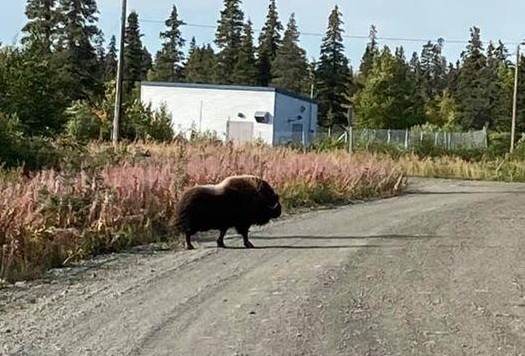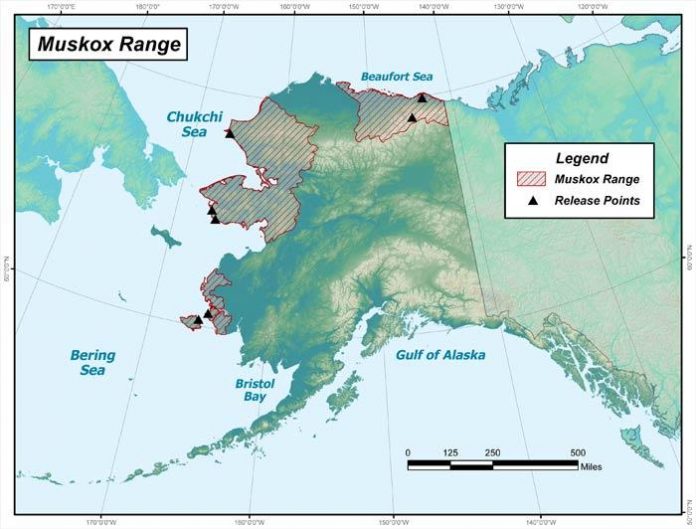
Melvin and Sally Andrew were out in Manokotak in the early morning, looking for moose, when they spotted a large creature.
“She said, ‘A moose! A moose!’” Melvin said. “But I spy-glassed it and I saw the telltale signs of muskox horns. I said some explicit words — ‘What is he doing here?'”
The Andrews approached the muskox thinking it would leave, but it didn’t budge. It dipped out of sight, but they managed to catch a glimpse of the animal walking away and snapped a photo.
Muskox are native to the Yukon Delta National Wildlife Refuge. They can grow to be five feet tall and weigh somewhere between 600-800 pounds. They have long hair, a slight shoulder hump and very short tail. Both males and females have horns, but the bulls’ are larger and heavier.
Pat Jones is a wildlife biologist for the Alaska Department of Fish and Game in Bethel. Jones said this particular animal was an adult bull that moseyed down from the Nelson Island herd.
“The bulls seem to have a lot more wanderlust, they go on longer walkabouts,” he said. “They show up in areas first, and maybe five years to 10 years later we start seeing cows in the areas that we saw bulls. That’s kind of the historical pattern we’ve seen across the landscape. But there’s been some moving your direction for years.”
About a year ago, muskox were spotted by residents in villages around the Togiak Wildlife Refuge. Jon Dyazuk is the village refuge liaison.
“First sighting we had was last spring,” Dyazuk said. “It was a muskox that a village member sent us that was in Chagvan Bay.” He said that another muskox was sighted near Platinum soon after.
Muskox disappeared from Alaska in the 1920s. A federal initiative reintroduced the animals a decade later, bringing over 34 muskox from East Greenland to Nunivak Island, off the west coast of the state.

By the 1970s, the state transported some of the animals from Nunivak to establish new herds on the Seward Peninsula, Cape Thompson, the Nelson Island and the Arctic National Wildlife Refuge. ADF&G reported a total of about 5,300 muskox in Alaska in 2011.
There are no official population counts of muskox in Bristol Bay due to their low presence in the region.
But what happens if you encounter a muskox? Unlike moose or caribou, they usually will not acknowledge a person’s presence. Rather, a muskox will get defensive and back itself into a corner until it feels it’s safe to leave. But Jones says they will go on the offensive with canines.
“Probably a self-defense mechanism that goes back to the Ice Age,” he said. “They will kill dogs if they get the chance. If there’s a muskox around and you have a dog on a chain, you’ll want to bring it inside for a day or two till the muskox passes. Every year, muskox kill dogs that are chained up outside.”
Muskox hunting is not permitted in Bristol Bay, and there’s a closed moratorium in other regions of the mainland — Units 18 and 22 B,C, D and E, and in Unit 23. People can register for muskox hunting through June 30, 2021.
Video courtesy of Melvin and Sally Andrew
